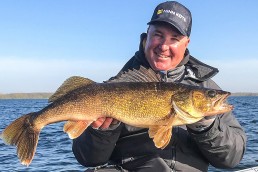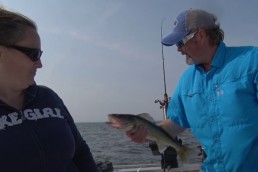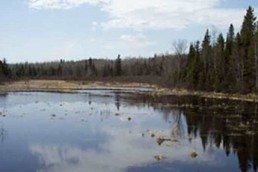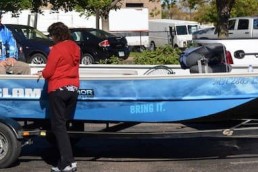The One-Boat Network
SHARE THIS POST
Recently airing on MidWest Outdoors Television was a show filmed on Sturgeon Bay of Lake Michigan. Long-time buddy Mark Courts and myself spent a couple days chasing walleyes in less than ideal conditions—an early season cold front accompanied by plenty of wind. Fortunately, the show was scheduled to be centered around technology, with the One-Boat Network from Humminbird and Minn Kota in play. Finding fish in rough conditions in big wind presents a challenge for any angler when it comes to good boat position techniques, but it’s something that this system simplifies. I wouldn’t say that the adverse conditions were just what we hoped for, but they were somewhat conducive to the task at hand.
So without the time constraint of a TV segment, this article will serve as a supplement to the show and allow for a more in-depth look at the network’s features, capabilities, and potential.
By definition, the One-Boat Network consists of Humminbird and Minn Kota products linked together, enabling communication and data sharing between them. The main players most commonly connected in the network are an i-Pilot Link capable trolling motor, Humminbird fish finders, and Talon shallow water anchors. It could be a couple devices, or a multitude. For example, on my smaller boat that I use for river fishing and small remote lakes, I have just two devices networked—a Minn Kota trolling motor and my Humminbird Helix fish finder. On my larger boat, I have eight devices linked. It’s a misconception that networked fishing systems are only to reside on high-end tournament-ready boats. While you’ll certain find plenty of them in that realm, I’d miss the minimal system on my little skiff just as much as I would the larger system on my big Skeeter Deep-V. Both systems have become invaluable components of my fishing gear. Let’s dive into some of what the One-Boat Network can do, and you’ll see why.
A GPS ‘anchor’
Unless you haven’t been around the fishing scene for awhile, you’ve probably heard the term “Spot-Lock.” Spot-Lock is a Minn Kota feature, a GPS anchor if you will, that when activated uses the trolling motor to keep the boat in the selected position automatically, without continued user interaction. In addition to the obvious application of maintaining boat position while fishing a particular structure, Spot-Lock is ideal for holding the boat any time you don’t want to drift but can’t tend the trolling motor- fighting fish, retying lines, or re-baiting. No more getting pushed off the spot by heavy wind or current. Like many of the One-Boat features, Spot-Lock can be enabled from multiple locations, such as a remote or a Humminbird. More on that to follow.
Precise boat positioning
This lesser known feature works with Spot-Lock to make ultra-precise adjustments to boat position, five feet at a time. While spot-locked, a tap on any directional key of the actual remote or Humminbird interface will move the boat in that direction, in five-foot increments. So two taps to the left and four up, and the boat moves 10 feet to the left and 20 feet ahead, and then returns to Spot-Lock. It allows you to dissect a piece of structure, while concentrating on precise casts—not on controlling the boat. It’s perfect for methodically working a complex weed line, while eliminating the chance of running up on fish before casting to them (not that I ever do this). JOG is also a great way of policing yourself from moving too fast at times when you shouldn’t be.
Follow
As you might be thinking, the heartbeat of the One-Boat Network is i-Pilot Link. It ties Minn Kota trolling motors, Humminbird fish finders, and LakeMaster maps together to take boat control to another level.
In its simplest form, the follow feature will track any LakeMaster depth contour line that you select. Seeing fish stacked at 25 feet? Select that contour and stay right on them. What about shallow fishing, roaming five feet? They likely won’t tolerate the boat on top of them that shallow, but no worries. Use Follow Offset and follow the five-foot contour with an offset of 60 feet. This will keep you off the fish, yet just an easy cast away.
But follow isn’t limited to existing contour lines, it’s able to use AutoChart Live data as well, including vegetation and bottom hardness! AutoChart Live is a real-time digital mapping feature built into many Humminbird units, and one of the coolest features ever. I live in an area surrounded by 1,000 lakes, and 998 of those lakes have really poor maps. Most are included in the LakeMaster list, but they were created off of the only available charts—various natural resources field studies from the 1970s (and earlier), so they really don’t show much for contours, and what is there is pretty inaccurate. So when I find an interesting area on my Humminbird, I turn on AutoChart Live, make a couple passes with the boat, and have instant detailed depth contours. And as summer moves on and fish begin to relate to subtle transitions in bottom composition, using Follow on bottom hardness contours can be wicked.
Are you enjoying this post?
You can be among the first to get the latest info on where to go, what to use and how to use it!
And more…
I could fill half this magazine with features and how I use them. Each angler will find which of them fit into their fishing style, and new features get added as the system evolves. I will say that the more I fish, the more features I find myself using. Here’s just a few more that I personally use pretty much every time on the water.
iTracks are recordable paths in the water that can be saved for recall. You can retrace them later from either direction. Backtrack will automatically retrace your current iTrack. I use this all the time after making a successful drift. Pay attention to your drift speed, select Backtrack, and adjust to that speed.
In the Go To menu you can have the Minn Kota navigate to previously stored items like, waypoints, iTracks (including Backtrack), and Spot-Locks. I use this constantly to navigate to my next waypoint while I’m changing out rods, re-rigging, or digging in the cooler. I use Advanced AutoPilot when I don’t have a predetermined reference point, and just want to go over there. With Advanced AutoPilot, just point your Minn Kota where you want to go and enable. It will stay on that bearing, adjusting for wind and current, until you tell it not to. Just a one button tap—so simple yet so useful.
Circle is a recently added feature, that will circle a waypoint at an offset distance and speed that you select. I first used this for casting to isolated patches of cabbage for Lake of the Woods muskies, which worked ideally, but I’m still finding other uses for it. Anytime you need to fish an isolated structure, and changing presentation angle is important—deep cranking bass for example.
Control from anywhere
Many of the One-Boat features can be employed from multiple locations: the trolling motor foot pedal, a remote control, a Humminbird screen, or the FishSmart App on a mobile device. For example, any function that I can perform from my Minn Kota Talon shallow water anchor remote, I can perform from any of my Humminbirds. It’s a welcomed redundancy to be able to deploy a Talon, enter Spot-Lock, or adjust the Minn Kota direction and speed from the bow, helm, or stern.
The FishSmart App not only can function as an additional remote. Via a mobile device and a Bluetooth connection, it can be used to update Humminbird software—no more memory card shuffling required to get the latest features into your units. Using the same connection, the app also allows users with a ChartSelect account to download LakeMaster maps of individual lakes to their Humminbird units, without the use of a computer. Slick.
Compatibility
As mentioned before, i-Pilot Link is the heart of the One-Boat Network, and the components need to be compatible. The growing number of products that are compatible with the system can be found at: MinnKotaMotors.com/iPilotLink.
Technology—a word that strikes fear into many, often unjustly interpreted as complicated. Quite possibly, the speak traveling back and forth between my Minn Kota and Humminbirds may very well fit that interpretation, but I assure you that the operation of them through the various input methods is not. The user interface is very intuitive and learned quickly. I’m talking minutes, not hours. I’ll argue that it simplifies, not complicates my fishing. And it’s not just for highly experienced anglers, it’s for all anglers. In fact, the less experienced an angler is with boat control, the more benefit they’ll likely get from the system. Boat control is one of the most important (and most difficult) aspects of catching fish. The One-Boat Network tames that beast while maximizing fishing time, and allowing you to concentrate on catching fish rather than controlling the boat.
MWO
MWO
SHARE THIS POST
Did you enjoy this post?
You can be among the first to get the latest info on where to go, what to use and how to use it!
Scott Walsh
MidWest Outdoors works with more than 200 outdoor experts each year, who contribute articles based on their areas of expertise. MidWest Outdoors magazine offers more fishing and hunting articles than any other publication!



